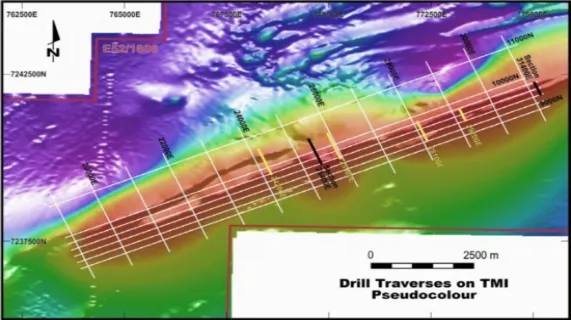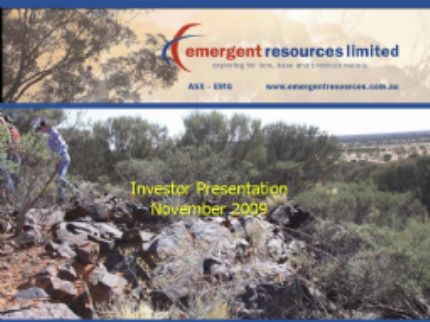
Location of drill hole traverses on detailed processed magnetics
Perth, June 9, 2009 AEST (ABN Newswire) - Emergent Resources Limited (ASX:EMG) is pleased to announce results from its 2nd phase drilling program at the company's flagship Beyondie Iron Project in the northern part of Western Australia's mid-west iron ore region.
The drill program comprised 25 Reverse Circulation (RC) holes totalling 3441 metres and was completed in early May. Additionally, three holes from the phase one drill program were reentered and deepened by 145 metres.
The Company is delighted with the results, which returned wide intervals of magnetite mineralisation (below generally shallow transported covers and weathered bedrock). See Table 1 and 2 for significant intercepts at a 25% and 20% Fe cut off. The grade compares favourably to similar developing magnetite operations in Western Australia.
Results achieved to date continue to confirm the world class development potential of the Beyondie Project.
Preliminary geological and resource modelling of the magnetite horizons (supported by the geophysical models) is complete and will be further tightened and remodelled this month to determine a maiden JORC resource statement.
Emergent's Managing Director, Garry Hemming, said: "The results have exceeded expectations with the consistency of the magnetite schist zones apparent over large distances. The width of the zones is remarkable and the shallow dip gives a bonus of increased potential tonnes per vertical metre."
"The understanding of the deposit has improved dramatically with this drilling and we are looking forward to reporting a preliminary resource figure soon and expanding on that as quickly as possible," Mr Hemming said.
Geology and drilling
The informally named Beyondie Magnetite Schist (BMS) forms the main host rock. It comprises three siliceous, magnetite-rich horizons (indentified as BMS1, BMS2 and BMS3)
The BMS possibly represents a highly deformed (folded and faulted) Banded Iron Formation (BIF). It is essentially composed of two minerals (in decreasing order of abundance): Silica and magnetite, with minor accessory feldspar and chlorite. The recrystallised unit lacks the classic alternating banding of silica and magnetite of true BIF's. Similar magnetite-bearing deposits are known for their high grade, and relative purity.
The Phase 2 drilling was designed to improve the geological understanding of the grade distribution and geometry of the BMS bands. The drill program covered a 7km segment of the known 45km total strike length at Beyondie. Thirty three kilometres of strike remains open and largely untested by the Company. The second phase drilling was focused within the limits of the Phase 1 drill program and concentrated where the BMS bands 1 and 2 are spatially closest to each other. It also targeted the cores of several magnetic highs associated with semi-continuous horizons of northeast-striking magnetite schist.
1500 two metre composite samples were submitted to Spectrolabs Laboratories in Geraldton for a suite including Fe, Al, Si, P, S, Mn, Ti, K, Mg, Na, and LOI. Magnetite measurements per composite sample where also recorded by a Magnasat instrument, which measures the abundance of magnetite in a sample, and generally serves to confirm the iron assay. Geological confidence in the magnetite distribution within the deposit is demonstrated by the high correlation between the returned assay value, Magnasat value, and field measured magnetic susceptibility.
Metallurgy
Equally encouraging, elements potentially deleterious in the iron and steel-making process were found to be at low levels in the test work concentrates. Ore beneficiation is expected to improve the ore specifications with near-removal of the deleterious elements. For example, the magnetite concentrates average only 0.01% Phosphorous, an exceptionally low value.
The completed metallurgical test work has shown that silica can be floated off reducing to less than the maximum specification of 5%, while retaining greater than 90% of magnetite concentrate providing a suitable product for the market.
Work is continuing with engineers and metallurgists on desk top studies covering metallurgy; process and engineering aspects, transport options, and approvals on environment, government, and community issues. This is to be followed with a Pre-scoping study which will include further drilling (both RC and Diamond coring) based on the working geological modelling of the magnetite horizons (supported by the geophysical models).
About the Beyondie Project
The exploration licences cover multiple magnetite-bearing banded iron formations (Locally termed Beyondie Magnetite Schist locally - BMS) over a 45 kilometres strike length. The BMS are being targeted by Emergent for large volumes of iron in the form of magnetite. The Company plans to develop the Beyondie Iron Project into a long life magnetite concentrate mining operation similar to others developing in the region The operation could potentially produce a magnetite concentrate of +68%Fe with very low impurities of aluminium (Al), titanium (Ti), phosphorous (P), and sulphur (S).
The Goldfields Gas Pipeline traverses the leases for potential access to cost effective power, and the Great Northern Highway is located just west of the Project allowing transport of concentrate north to Newman (160 kilometres by road) or south to connect to the developing Mid West iron mining centre.
Emergent is of the view that there will be strong demand for magnetite in the future due to the diminishing grade of hematite mines in the Pilbara of Western Australia and in Brazil, and corresponding increasing impurities. The Beyondie Project is located north of the developing Mid West Iron Province of Western Australia, immediately adjacent to the Great Northern Highway and Goldfields Gas Pipeline. Potential shared rail and port infrastructure developments are in progress.
Magnetite versus Hematite
Magnetite occurs in lower grade deposits than hematite however is beneficiated to a high grade concentrate which is sought after for Direct Reduction (DR) feed in the smelting process. It has very low impurities which can disrupt production and DR does not require coking coal. It attracts a premium price.
Discussions with potential offtake partners
The Company can also report that after two successful visits to China to meet with Chinese parties regarding potential participation in the Beyondie Project it has now short listed a select number of groups that it intends to pursue ongoing dialogue with a view to develop mutually acceptable parameters for off-take arrangements and investment partnerships for the development of the project.
For the complete Emergent Resources Company Announcement, please click the link below;
http://www.abnnewswire.net/media/en/docs/60865-ASX-EMG-449219.pdf
Contact
Garry Hemming
Managing Director
Emergent Resources
Mob: +61-419-835-757
Email: ghem@westnet.com.au
www.emergentresources.com.au
| ||
|








